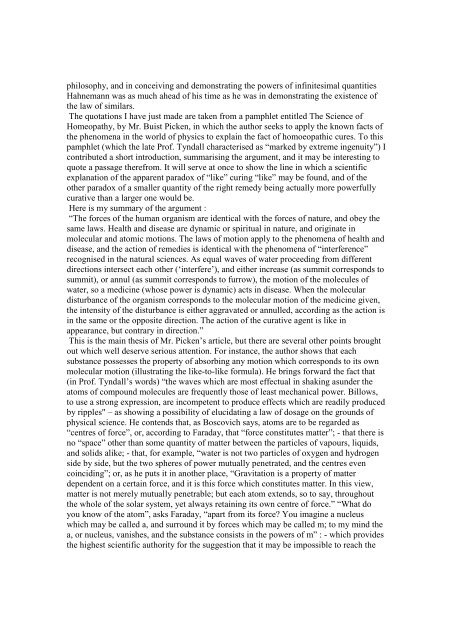CLARKE JH, Homoeopathy Explained - Classical Homeopathy Online
CLARKE JH, Homoeopathy Explained - Classical Homeopathy Online
CLARKE JH, Homoeopathy Explained - Classical Homeopathy Online
Create successful ePaper yourself
Turn your PDF publications into a flip-book with our unique Google optimized e-Paper software.
philosophy, and in conceiving and demonstrating the powers of infinitesimal quantities<br />
Hahnemann was as much ahead of his time as he was in demonstrating the existence of<br />
the law of similars.<br />
The quotations I have just made are taken from a pamphlet entitled The Science of<br />
<strong>Homeopathy</strong>, by Mr. Buist Picken, in which the author seeks to apply the known facts of<br />
the phenomena in the world of physics to explain the fact of homoeopathic cures. To this<br />
pamphlet (which the late Prof. Tyndall characterised as “marked by extreme ingenuity”) I<br />
contributed a short introduction, summarising the argument, and it may be interesting to<br />
quote a passage therefrom. It will serve at once to show the line in which a scientific<br />
explanation of the apparent paradox of “like” curing “like” may be found, and of the<br />
other paradox of a smaller quantity of the right remedy being actually more powerfully<br />
curative than a larger one would be.<br />
Here is my summary of the argument :<br />
“The forces of the human organism are identical with the forces of nature, and obey the<br />
same laws. Health and disease are dynamic or spiritual in nature, and originate in<br />
molecular and atomic motions. The laws of motion apply to the phenomena of health and<br />
disease, and the action of remedies is identical with the phenomena of “interference”<br />
recognised in the natural sciences. As equal waves of water proceeding from different<br />
directions intersect each other (‘interfere’), and either increase (as summit corresponds to<br />
summit), or annul (as summit corresponds to furrow), the motion of the molecules of<br />
water, so a medicine (whose power is dynamic) acts in disease. When the molecular<br />
disturbance of the organism corresponds to the molecular motion of the medicine given,<br />
the intensity of the disturbance is either aggravated or annulled, according as the action is<br />
in the same or the opposite direction. The action of the curative agent is like in<br />
appearance, but contrary in direction.”<br />
This is the main thesis of Mr. Picken’s article, but there are several other points brought<br />
out which well deserve serious attention. For instance, the author shows that each<br />
substance possesses the property of absorbing any motion which corresponds to its own<br />
molecular motion (illustrating the like-to-like formula). He brings forward the fact that<br />
(in Prof. Tyndall’s words) “the waves which are most effectual in shaking asunder the<br />
atoms of compound molecules are frequently those of least mechanical power. Billows,<br />
to use a strong expression, are incompetent to produce effects which are readily produced<br />
by ripples" – as showing a possibility of elucidating a law of dosage on the grounds of<br />
physical science. He contends that, as Boscovich says, atoms are to be regarded as<br />
“centres of force”, or, according to Faraday, that “force constitutes matter”; - that there is<br />
no “space” other than some quantity of matter between the particles of vapours, liquids,<br />
and solids alike; - that, for example, “water is not two particles of oxygen and hydrogen<br />
side by side, but the two spheres of power mutually penetrated, and the centres even<br />
coinciding”; or, as he puts it in another place, “Gravitation is a property of matter<br />
dependent on a certain force, and it is this force which constitutes matter. In this view,<br />
matter is not merely mutually penetrable; but each atom extends, so to say, throughout<br />
the whole of the solar system, yet always retaining its own centre of force.” “What do<br />
you know of the atom”, asks Faraday, “apart from its force? You imagine a nucleus<br />
which may be called a, and surround it by forces which may be called m; to my mind the<br />
a, or nucleus, vanishes, and the substance consists in the powers of m” : - which provides<br />
the highest scientific authority for the suggestion that it may be impossible to reach the
















